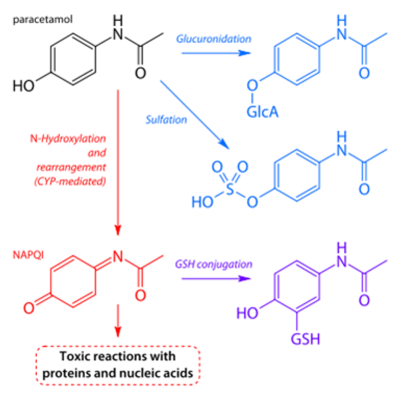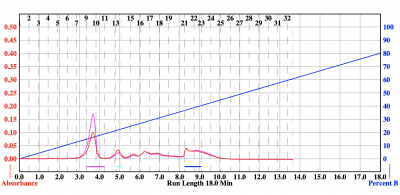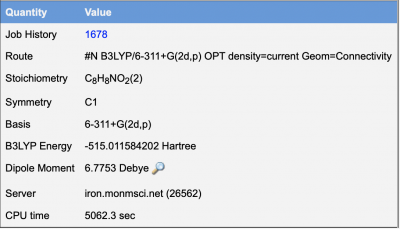Acetaminophen Project
The following document was completed by William B Fox in Spring of 2021 in partial fulfillment of his requirements for a Bachelor's Degree of Science in Biochemistry, Monmouth College, Monmouth, Il 61462. The research was done under the supervision of Bradley E. Sturgeon.
Abstract
Acetaminophen(APAP) is an active ingredient in many over-the-counter and prescription painkillers, such as Tylenol and Oxycodone. APAP is also responsible for approximately 50% of the cases of acute liver-failure in the United States and Great Britain(1). Treatments for acetaminophen-induced liver injury(AILI) are limited. The current mechanism for AILI is the production of hepatotoxic NAPQI as a metabolite in an enzymatic, two-electron oxidation(1). However, evidence also supports a one electron oxidation(2). In an effort to reduce the mortality rate of acetaminophen overdose, we are investigating the identity of single-electron oxidation products and their bioactivity as an alternative mechanism for AILI. An oxidation product of APAP was isolated via high performance liquid chromatography (HPLC) and subsequent flash chromatography. The evidence of a radical intermediate was proven via EPR. The dimer was further oxidized and a novel product was observed. These oxidation products can be isolated, identified, and investigated further in order to assess the overall mechanism of AILI.
Introduction
Acetaminophen (Figure 1), often referred to as "APAP" is an active ingredient in many over-the-counter and prescription painkillers, such as Tylenol and Oxycodone. The mechanism of pain relief has still not been proven thoroughly. The drug works to raise the pain threshold for a person, effectively increasing the body's requirement for more pain signals in order to feel pain. One of the players in pain are prostaglandins (PG). These are lipid molecules that are made at the site of tissue damage that cause inflammation, and inflammation causes pain (3). Prostaglandins do many other physiological jobs such as protecting the lining of the stomach (3). Enzymes that produce prostaglandins are called cyclooxygenases. These enzymes are often the target for analgesics. APAP originally was thought to inhibit prostaglandin formation in the brain, but was later disputed (3). This was due to the finding that APAP does not suppress PG formation in broken cells, but intact cells(3). Thus, APAP is regarded as a weak inhibitor of both COX-1 and COX-2 enzymes. However, APAP does not have a harmful effect on the gastrointestinal tract, does not affect platelet function, and does not cause breathing issues in asthmatics and therefor has been theorized to be be a selective COX-2 inhibitor (3). Further research showed that APAP is 4.4 times more likely to be selective for COX-2 than COX-1(3). Since this is the case, long term usage of APAP should be cautioned due to potential cardiovascular issues (3).
APAP is also responsible for approximately 50% of the cases of acute liver-failure in the United States and Great Britain(1). Treatments for acetaminophen-induced liver injury(AILI) are limited. The current mechanism for AILI is the production of hepatotoxic NAPQI as a metabolite in an enzymatic, two-electron oxidation(1). At the overdose of acetaminophen, glutathione is depleted by binding to NAPQI. When glutathione is depleted 70% or more, NAPQI can no longer be detoxified by that pathway, and the excess of NAPQI binds covalently to cellular protein macromolecules in the liver, causing cell death and hepatic necrosis (4). Currently, there is only one approved treatment for acetaminophen overdose and that is a compound called N-acetylcysteine (NAC). Administration of NAC (<8 hours after ingestion) is crucial for decreasing the risk of hepatotoxicity. There are several side effects after administration and caution should be used when dealing with the compound. It is thought to provide cysteine for glutathione synthesis and possibly to form an adduct directly with the toxic metabolite of acetaminophen, N-acetyl-p-benzoquinoneimine (5). However, this has not been proven in vivo.
Evidence also supports a one electron oxidation(2). A radical intermediate was detected via ESR in the 1980s(6,7). Specifically, a phenoxyl radical was detected and subsequent polymeric material formed(6,7). Thus, this radical chemistry could be forming biologically active products that contribute to hepatotoxicity. The oxidation products were also identified shortly after via nuclear magnetic resonance(2). However, there lacks evidence in the literature regarding isolation and further experimentation of these oxidation products. Therein lies the reason for investigating the identity of single-electron oxidation products and their bioactivity as an alternative mechanism for AILI. In order to determine the identities and properties of the single electron oxidation products, it is necessary to first synthesize them. The single electron oxidation can be accomplished by using a system of horseradish peroxidase (HRP) and hydrogen peroxide. HRP carries out two, single-electron oxidations of the substrate, APAP in this case. Cytochrome P450s (CYPs) metabolize countless fo endogenous and exogenous chemicals in the liver including APAP. CYPs do not bind, oxidize, and move on when encountering substances in the liver. These enzymes behave similar to a peroxidase- such as HRP. The HRP reaction ran in vitro (Figure 2) mimics the reactions that occur in the liver.
Pharmacokinetics & Pharmacodynamics
Therapeutic doses in adults range from 1-4 g/day. The minimum lethal dose is 5-15 g, with acute lethal doses ranging from 13-25 g (8). An acetaminophen dose of 150 mg/kg causes liver injury. Peak plasma concentrations are seen within 2 hours of ingestion. The half-life is usually 1-3 hours. The metabolites of acetaminophen stay in the body from 4-5 hours (9). Hepatotoxicity usually develops 24-36 hours after ingestion, whereas renal insufficiency may develop in 2 to 4 days (10).
Acetaminophen is absorbed from the gastrointestinal tract and exhibits dose-dependent kinetics (first order). Plasma protein binding for acetaminophen is between 20 and 50%, and passage of the blood-brain barrier is restricted. Elimination of the metabolized drug is though the kidney (10,11).
Metabolism and Excretion
About 90% of acetaminophen is biotransformed by cytochrome P-450 in the liver. Main metabolites are sulphate (about 52%) and glucuronide (about 42%) conjugates. About 4% of the drug is biotransformed to N-acetyl-p-benzoquinoneimine (NAPQI), which is a highly reactive cytotoxic intermediate. NAPQI is detoxified by conjugation with glutathione and excreted in the urine as cysteine and mercapturic acid (10,11).90-100% of an ingested dose is excreted in urine during about 24 h (12). Approximately 2 % of acetaminophen is excreted unchanged (13).
Materials and Methods
Acetaminophen Sample Prep
Early Acetaminophen Trial Sample Preparation
A 2 mM acetaminophen pH 5 stock solution was prepared in 100 mL of nanopure water. Stock solutions of Hydrogen peroxide (0.413 M), and HRP were created. The experimental solutions of acetaminophen (2 mM), H2O2 (0.25 M, 0.5 M, 1 M, and 2M), and 10 uL of horseradish peroxidase was to each of a reaction vial. (NOTE: this method was to visualize the reaction on the HPLC. In order to obtain a more efficient reaction, the method was updated.)
Recent Acetaminophen Trial Sample Preparation
A 50 mM acetaminophen stock solution was prepared in 100 mL of nanopure water. Stock solutions of Hydrogen peroxide (0.413 M), and HRP were created. The APAP was added to a 1:1 water and dioxane solution. The experimental solutions of acetaminophen (50 mM), H2O2 (12.5mM), and ten uL of horseradish peroxidase was to each of a reaction vial. The resulting products were diluted by a factor of 10.
Sample Concentration
The solutions containing our oxidized APAP were spun on a Savant Speed Vac® SC110 with attached Labconco FreeZone 4.5 refrigeration trap for 3 hours until the vials showed a yellow powdery solid at the bottom. The solid was solubilized in lab-grade ethanol (2 mL) in preparation for flash chromatography.
HPLC
Reverse phase high pressure liquid chromatography (HPLC) was performed on an Agilent Technologies 1100 Series instrument using a C18 column at 28˚C. The experimental method consisted of a 30-minute long run with mobile phase beginning at 100 percent acidified water to 100 percent 30% volume to volume acetonitrile. UV/Vis spectroscopy was used as a detector for absorbance at 270 nm.
Flash Chromatography
The solubilized and concentrated products were combined and loaded onto a C18 RediSep Rf gold column. The column was loaded onto a Teledyne Isco CombiFlash Rf 200i instrument. The experiment was 18 minutes long and acetonitrile and acidified water were used. The method was arranged so that the mobile phase started at 100% acidified water and increased linearly until it was 80% acetonitrile and 20% acidified water. Once the peaks were all off the column, the run was terminated and the respective vials were collected.
EPR
A 50 mM solution of APAP pH 5 in 1:1 water to dioxane was made and subsequently diluted by a factor of 10. H2O2 (12.5mM) was added to the solution before loading in into a 60 mL syringe. Flow was analyzed at rates of 0.5 mL/minute and 1 mL/minute.
Enzyme Immobilization
An immobilization of peroxidase from horseradish (HRP) was completed using Affi-Gel® 10. This procedure is centered around the isolectric point of the enzyme. The immobilization was completed using a MOPS buffer (pH 7.0) and about 1 mL of Affi-Gel® 10 beads.
Results
Early research efforts to visualize the oxidation of APAP were successful (Figure 5) and four distinct oxidation products were observed as well as a large mass of products representing polymeric material. This aligns with the findings in the literature (2,6,7). The reaction method was adjusted as to concentrate the amount of APAP being oxidized to maximize the amount of product being formed, in addition to solubilizing the products in 1:1 water:dioxane for sufficient HPLC visualization (Figure 6). The "dimer" product was isolated via flash chromatography (Figure 8) and was further oxidized to form a single product shown in Figure 7. The product resulting from this experiment does not align with any of the initial APAP oxidation products, but this provides marginal evidence that the oxidation of APAP does form active compounds. Efforts were made to recreate previous EPR results from Sturgeon, however the data was inconclusive. Computational chemistry using "Web MO/Gaussian" simulated an EPR experiment (Figure 10; Figure 11) using the isotropic fermi contact couplings generated by the software and a pattern similar to the Sturgeon data can be observed. The software was also used to generate visual aids of where the radical can be located on the radicalized APAP molecule (Figure 12; Figure 13). Figure 13 shows that the radical localizes to the ortho positions on the APAP molecule. ΔHf calculations for the radical reaction on the phenoxyl were made using the values provided by the "Web MO/Gaussian" calculations using B3LYP/6-311+G(2d,p) basis sets. The results of a geometry optimization are given in Figure 11. A value of 1012.59 kJ/mol was found.
HPLC
Flash Chromatography
EPR
Computational Chemistry: Web MO/Gaussian
B3YLP/6-311+G(2d,p)
| Phenoxy (G) |
|---|
| 2.04 |
| 6.11 |
| 5.73 |
| 1.71 |
| 1.73 |
| 1.36 |
Radical Location
ΔHf Calculations
- ΔHrxn = ΔHf(Products) - ΔHf(Reactants)
- ΔHrxn = ΔHf[(-OH•) + (H+)]- Hf(-OH)
- ΔHrxn = (-515.01158420 + -0.08303 Hartree) - (-515.480291398 Hartree)
- ΔHrxn = 0.385677198 Hartree = 1012.59556048 kJ/mol
Discussion
The current mechanism for AILI is the production of hepatotoxic NAPQI as a metabolite in an enzymatic, two-electron oxidation(1). However, evidence shown in this project supports a one electron oxidation(2). The polymeric material formed during experimentation could have a hepatotoxic effect due to the nature of its size. Polymeric material was observed even in the early oxidation reactions (Figure 5). The oxidation products could also play a role in liver injury, this is plausible because the "dimer" was isolated and oxidized (Figure 7). There was a product that was not seen in the original APAP oxidation, so the dimer is biologically active and its resulting product could also be bioactive. The only way to know for sure is to repeat the isolation, identification, and experimentation processes shown in this project. So far the first oxidation product has been isolated and oxidized, however it needs to be identified via mass spectrometry. Once this is completed the second, third, and fourth products can be isolated, identified, and tested for bioactivity. Ascorbate could be used in addition to the original HRP/H2O2 experiment to model GSH-APAP interactions and gain further insight. Theoretically, once the products have been investigated thoroughly a new proposal of how AILI occurs in the liver and further treatments can be investigated.
References
1.) Hinson, Jack A., Dean W. Roberts, and Laura P. James. "Mechanisms of Acetaminophen-Induced Liver Necrosis." Handbook of Experimental Pharmacology Adverse Drug Reactions (2009): 369-405. Web.
2.) Potter, David W., Dwight W. Miller, and Jack A. Hinson. "Identification of Acetaminophen Polymerization Products Catalyzed by Horseradish Peroxidase." Journal of Biological Chemistry 260.22 (1985): 12174-2180. Print
3.) Hinz B, Cheremina O, Brune K. Acetaminophen (paracetamol) is a selective cyclooxygenase-2 inhibitor in man. FASEB J. 2008 Feb;22(2):383-90. doi: 10.1096/fj.07-8506com. Epub 2007 Sep 20. PMID: 17884974.
4.) Casarett and Doull’s Toxicology (The Basic Science of Poisons), (1986) Klaassen, C.D., Amdur, M.O., Doull, J., eds., Macmillan Publishing Company.
5.) Lauterburg, B. H., Corcoran, G. B., & Mitchell, J. R. (1983). Mechanism of action of N-acetylcysteine in the protection against the hepatotoxicity of acetaminophen in rats in vivo. The Journal of clinical investigation, 71(4), 980–991. doi:10.1172/jci110853
6.) Nelson, S. D., Dahlin, D. C., Rauckman, E. J., and Rosen, G.M. (1981) Mol. Pharmacol. 20,195-199.
7.) West, P. R., Harman, L. S., Josephy, P. D., and Mason, R. P. (1984) Biochem. Pharmacol. 33, 2933-2936.
8.) Winek, C.L. (1994) Drug and chemical blood-level data. Winek’s Toxicological Annual, Pittsburgh. Allegheny County Department Laboratories.
9.) Slattery, JT, Wilson, JM, Kalhorn, TF, Nelson, SD. Dose-Dependent Pharmacokinetics of Acetaminophen: Evidence of Glutathione Depletion in Humans. Clin Pharmacol Ther 1987. Apr. 41(4): 413-8
10.) Poisindex, Thomson Micromedex (2005).
11.) Dollery, C. (1993) Therapeutic Drugs, Vol 1 & 2, , ed., London: Churchill Livingstone.
12.) Dart, R.C. ed. (2004) Medical Toxicology, 3rd ed., , Lippincott, Williams & Wilkins.
13.)Haddad, L.M. & Winchester, J.F. (1990) Clinical Management of Poisoningand Drug Overdose, 2nd edn., Philadelphia, PA, USA: W.B. Saunders.
14.) Yan, M; Huo, Yazhen; Yin, Shutao; Hu, Hongbu. “Mechanisms of Acetaminophen-Induced Liver Injury and Its Implications for Therapeutic Interventions.” Redox biology. 17 (2018): n. pag 274-283. Web.













